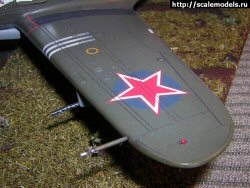
Eduard 1/48 P-39Q Airacobra Build Review
By Michael Neradkov
| Date of Review | March 2006 | Manufacturer | Eduard |
|---|---|---|---|
| Subject | P-39Q Airacobra | Scale | 1/48 |
| Kit Number | 8065 | Primary Media | Styrene, Resin, Photo-Etch |
| Pros | Nice detail | Cons | |
| Skill Level | Intermediate | MSRP (USD) | $37.95 |
Background
Editor's Note: Michael Neradkov is not only an accomplished modeler and writer, he is also webmaster of Scalemodels.ru.
P-39Q-5-BE Airacobra of the commander's assistant of 3rd Air Squadron of 30th Guards Independent Aviation Regiment (273rd Independent Aviation Division, 16th Air Army) - senior Lieutenant A.P.Filatov, Poland, Autumn, 1944.
Aleksandr Pavlovich Filatov, (1 April 1922 -??). Not your typical fighter pilot, he loved Russian literature and especially poetry. He was modest and didn’t boast of his combat victories. His demeanor changed little when sitting down in the cockpit of his P-39. He quietly listened to his mechanic’s report, put on his parachute, attentively inspected his rear hemisphere and then departed into the air.
Once airborne however, his modesty disappeared - after completing 175 combat missions, in 35 air battles he shot down 21 aircraft personally and assisted in downing four others. Twice he was shot down and was taken prisoner, and both times he escaped and returned to combat.
The Airacobra of Filatov is very interesting by the uncommon nose-art for USSR VVS - three playing cards near the cockpit.
The Kit
It is safe to say that this model is built almost straight from the box...but a Profipacked box. Eduard's Airacobra's are widely known to modelers - there are no real competitors in 1/48 scale. This model is very remarkable. In addition to the beautifully molded plastic parts, the kit includes a fret of photo-etch with the fine details, painting masks, and small weight for the nose section.
The model is assembled according to the instructions with only two self-induced problems arose:
- The small weight was glued into the nose section backwards; therefore nose was a little flared and opened a seam line after assembly that had to be puttied. The small distortion of if the fuselage led to the fact that the cockpit enclosure, doors and spinner did not want to fit properly either.
- In the process of the painting of cockpit enclosure, the mask fell away and the paint went on transparent plastic. It was necessary to remove the affected transparency and to polish it, but in the process of polishing the plastic it cracked.The attempts to flood the small cracks using Glanzer (Future equivalent) did not succeed and I can not find a replacement.
To finish the model, - jacket of the main gun and machine guns were fashioned from hypodermic needles, the exhaust stacks hollowed out, the "ears" on the wing-guns from the thin tin, and I changed the location of the navigation lights to fit the drawings.
Painting
I know of three profiles for A.P.Filatov’s Airacobra:
- War in Air #45 - "Combat Employment of P -39 Airacobra"
- Article "30 Guard Fighters Squadron" by Vasiliy Vakhlamov. The artist of this profile - Mr. Svinkov
- Painting instruction to Eduard's model
The airframe was primed using AKAN metalizers and ABRO automobile's paint to provide a foundation where the paint would later “wear through”.
Next came the pre-shading - along the panel lines are applied thin strips of black color. Then the spaces between them accurately painted by the necessary color - as a result the aircraft has a worn look. All paints used in this model - the AKAN enamels.
After the paint had dried, the model finish is buffed with fine sandpaper (1500-2000 grit) with water for the smoothing of rough edges of paint.
Decals & Weathering
After paining the model - layer of Glanzer gloss was applied to apply the decals from the kit. Eduard uses Cartograph decals (Italy) - excellent quality, and they lay practically without effort, though I help them along with a little MicroSol. After a day of drying - one additional layer of Glanzer gloss is applied over the decals.
A wash was made using artistic acryl manufactured in St. Petersburg - brown from below and black-brown on top of aircraft. Then last layer – applying a semi-matt coating from the AKAN. By the way - this is simply light-grey paint with a certain degree of dullness.
Final touches: engine exhaust stains and "pant chips," dry brushing some elements. For the antenna the "Hobby-plus" special thread proved to be sufficiently interesting material. Easily painted and glued, it flexible and it is also possible to select the necessary thickness.
The mechanic comes from the Alanger's kit, painted with St. Petersburg artistic acryl.
The base is made from Plexiglas, then the earth made from the soda & superglue, concrete runway from the cardboard and grass made from dill.
References:
- P-39 Airacobra Reference Section
- Detail & Scale #63 - P-39 Airacobra in Detail
- Mushroom Yellow Series #6106 - Bell P-39 Airacobra
- War in the Air #27, 28 - P-39 Airacobra (part 1, 2)
- War in the Air # 45 - Combat Employment P -39 Airacobra
- Monografie Lotnicze - Bell P-39 Airacobra
- Squadron #043 - P -39 Airacobra in Action
- Vasiliy Vakhlamov's article "30th Guard Fighter Squadron"
P.S. Special thanks to Alex Ruchkovskiy (AR) and all my comrades for their assistance and with the photographs.















